Microsoft DP-900 Exam Practice Questions (P. 2)
- Full Access (316 questions)
- Six months of Premium Access
- Access to one million comments
- Seamless ChatGPT Integration
- Ability to download PDF files
- Anki Flashcard files for revision
- No Captcha & No AdSense
- Advanced Exam Configuration
Question #11
HOTSPOT -
To complete the sentence, select the appropriate option in the answer area.
Hot Area:

To complete the sentence, select the appropriate option in the answer area.
Hot Area:

Correct Answer:

Disadvantages of non-relational databases include: Data Consistency ג€" non-relational databases do not perform ACID transactions.
Note: Relational databases are optimized for writes. They are optimized for consistency and availability. Advantages of relational databases include simplicity, ease of data retrieval, data integrity, and flexibility.
Incorrect Answers:
Use a relational database when data that you work with is structured, and the structure is not subject to frequent changes.
Use Cloud storage (no relational database) for geographically distributed writes.
Reference:
https://towardsdatascience.com/choosing-the-right-database-c45cd3a28f77

Disadvantages of non-relational databases include: Data Consistency ג€" non-relational databases do not perform ACID transactions.
Note: Relational databases are optimized for writes. They are optimized for consistency and availability. Advantages of relational databases include simplicity, ease of data retrieval, data integrity, and flexibility.
Incorrect Answers:
Use a relational database when data that you work with is structured, and the structure is not subject to frequent changes.
Use Cloud storage (no relational database) for geographically distributed writes.
Reference:
https://towardsdatascience.com/choosing-the-right-database-c45cd3a28f77
send
light_mode
delete
Question #12
HOTSPOT -
For each of the following statements, select Yes if the statement is true. Otherwise, select No.
NOTE: Each correct selection is worth one point.
Hot Area:
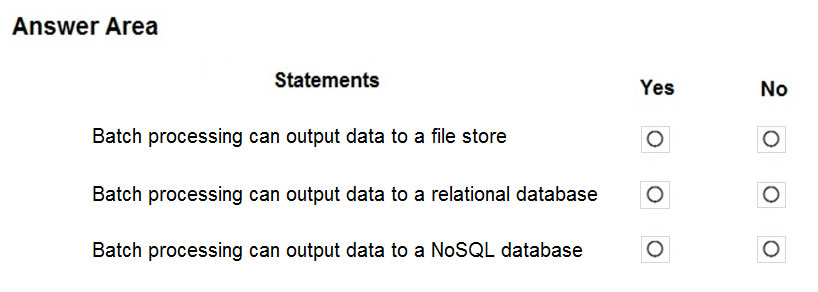
For each of the following statements, select Yes if the statement is true. Otherwise, select No.
NOTE: Each correct selection is worth one point.
Hot Area:

Correct Answer:
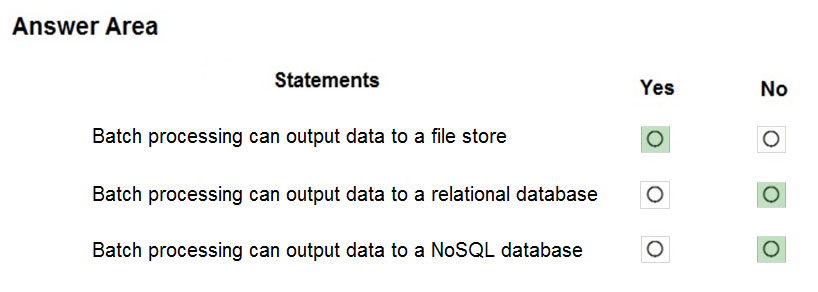
Box 1: Yes -
Big data solutions often use long-running batch jobs to filter, aggregate, and otherwise prepare the data for analysis. Usually these jobs involve reading source files from scalable storage (like HDFS, Azure Data Lake Store, and Azure Storage), processing them, and writing the output to new files in scalable storage.
Box 2: No -
Box 3: No -
Reference:
https://docs.microsoft.com/en-us/azure/architecture/data-guide/big-data/batch-processing

Box 1: Yes -
Big data solutions often use long-running batch jobs to filter, aggregate, and otherwise prepare the data for analysis. Usually these jobs involve reading source files from scalable storage (like HDFS, Azure Data Lake Store, and Azure Storage), processing them, and writing the output to new files in scalable storage.
Box 2: No -
Box 3: No -
Reference:
https://docs.microsoft.com/en-us/azure/architecture/data-guide/big-data/batch-processing
send
light_mode
delete
Question #13
DRAG DROP -
Your company plans to load data from a customer relationship management (CRM) system to a data warehouse by using an extract, load, and transform (ELT) process.
Where does data processing occur for each stage of the ELT process? To answer, drag the appropriate locations to the correct stages. Each location may be used once, more than once, or not at all. You may need to drag the split bar between panes or scroll to view content.
NOTE: Each correct selection is worth one point.
Select and Place:
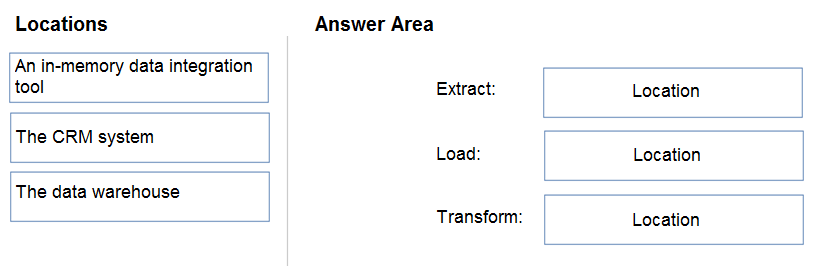
Your company plans to load data from a customer relationship management (CRM) system to a data warehouse by using an extract, load, and transform (ELT) process.
Where does data processing occur for each stage of the ELT process? To answer, drag the appropriate locations to the correct stages. Each location may be used once, more than once, or not at all. You may need to drag the split bar between panes or scroll to view content.
NOTE: Each correct selection is worth one point.
Select and Place:

Correct Answer:
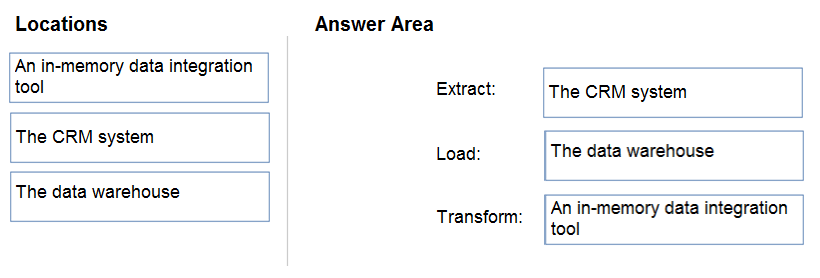
Box 1: The CRM system -
Data is extracted from the CRM system.
Box 2: The data warehouse -
Data is loaded to the data warehouse.
Box 3: An in-memory data integration tool
The data transformation that takes place usually involves various operations, such as filtering, sorting, aggregating, joining data, cleaning data, deduplicating, and validating data.
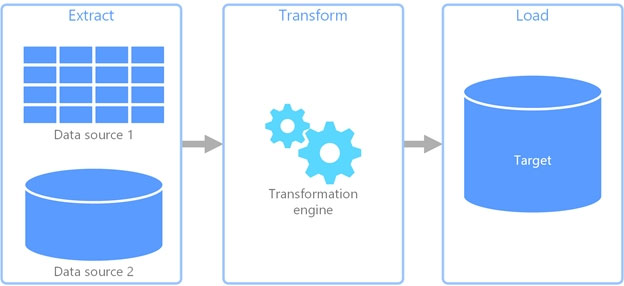
Reference:
https://docs.microsoft.com/en-us/azure/architecture/data-guide/relational-data/etl

Box 1: The CRM system -
Data is extracted from the CRM system.
Box 2: The data warehouse -
Data is loaded to the data warehouse.
Box 3: An in-memory data integration tool
The data transformation that takes place usually involves various operations, such as filtering, sorting, aggregating, joining data, cleaning data, deduplicating, and validating data.

Reference:
https://docs.microsoft.com/en-us/azure/architecture/data-guide/relational-data/etl
send
light_mode
delete
Question #14
HOTSPOT -
To complete the sentence, select the appropriate option in the answer area.
Hot Area:

To complete the sentence, select the appropriate option in the answer area.
Hot Area:

Correct Answer:

Generally speaking, data analytics comes in four types (Figure 1):
Descriptive, to answer the question: What's happening?
Diagnostic, to answer the question: Why's happening?
Predictive, to answer the question: What will happen?
Prescriptive, to answer the question: What actions should we take?
Reference:
https://azure.microsoft.com/en-us/blog/answering-whats-happening-whys-happening-and-what-will-happen-with-iot-analytics/

Generally speaking, data analytics comes in four types (Figure 1):
Descriptive, to answer the question: What's happening?
Diagnostic, to answer the question: Why's happening?
Predictive, to answer the question: What will happen?
Prescriptive, to answer the question: What actions should we take?
Reference:
https://azure.microsoft.com/en-us/blog/answering-whats-happening-whys-happening-and-what-will-happen-with-iot-analytics/
send
light_mode
delete
Question #15
DRAG DROP -
Match the types of visualizations to the appropriate descriptions.
To answer, drag the appropriate visualization type from the column on the left to its description on the right. Each visualization type may be used once, more than once, or not at all.
NOTE: Each correct match is worth one point.
Select and Place:

Match the types of visualizations to the appropriate descriptions.
To answer, drag the appropriate visualization type from the column on the left to its description on the right. Each visualization type may be used once, more than once, or not at all.
NOTE: Each correct match is worth one point.
Select and Place:

Correct Answer:

Box 1: Tree map -
Treemaps are charts of colored rectangles, with size representing value. They can be hierarchical, with rectangles nested within the main rectangles.
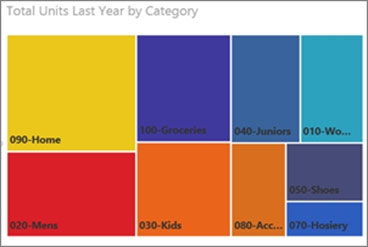
Box 2: Key influencer -
A key influencer chart displays the major contributors to a selected result or value.
Box 3: Scatter -
Scatter and Bubble charts display relationships between 2 (scatter) or 3 (bubble) quantitative measures -- whether or not, in which order, etc.

Box 1: Tree map -
Treemaps are charts of colored rectangles, with size representing value. They can be hierarchical, with rectangles nested within the main rectangles.

Box 2: Key influencer -
A key influencer chart displays the major contributors to a selected result or value.
Box 3: Scatter -
Scatter and Bubble charts display relationships between 2 (scatter) or 3 (bubble) quantitative measures -- whether or not, in which order, etc.
send
light_mode
delete
Question #16
You need to create an Azure Storage account.
Data in the account must replicate outside the Azure region automatically.
Which two types of replication can you use for the storage account? Each correct answer presents a complete solution.
NOTE: Each correct selection is worth one point.
Data in the account must replicate outside the Azure region automatically.
Which two types of replication can you use for the storage account? Each correct answer presents a complete solution.
NOTE: Each correct selection is worth one point.
- Azone-redundant storage (ZRS)
- Bread-access geo-redundant storage (RA-GRS)Most Voted
- Clocally-redundant storage (LRS)
- Dgeo-redundant storage (GRS)Most Voted
Correct Answer:
BD
D: Azure Storage offers two options for copying your data to a secondary region:
✑ Geo-redundant storage (GRS)
✑ Geo-zone-redundant storage (GZRS)
B: With GRS or GZRS, the data in the secondary region isn't available for read or write access unless there is a failover to the secondary region. For read access to the secondary region, configure your storage account to use read-access geo-redundant storage (RA-GRS) or read-access geo-zone-redundant storage (RA-
GZRS).
Reference:
https://docs.microsoft.com/en-us/azure/storage/common/storage-redundancy#redundancy-in-a-secondary-region
BD
D: Azure Storage offers two options for copying your data to a secondary region:
✑ Geo-redundant storage (GRS)
✑ Geo-zone-redundant storage (GZRS)
B: With GRS or GZRS, the data in the secondary region isn't available for read or write access unless there is a failover to the secondary region. For read access to the secondary region, configure your storage account to use read-access geo-redundant storage (RA-GRS) or read-access geo-zone-redundant storage (RA-
GZRS).
Reference:
https://docs.microsoft.com/en-us/azure/storage/common/storage-redundancy#redundancy-in-a-secondary-region
send
light_mode
delete
Question #17
HOTSPOT -
For each of the following statements, select Yes if the statement is true. Otherwise, select No.
NOTE: Each correct selection is worth one point.
Hot Area:

For each of the following statements, select Yes if the statement is true. Otherwise, select No.
NOTE: Each correct selection is worth one point.
Hot Area:

Correct Answer:
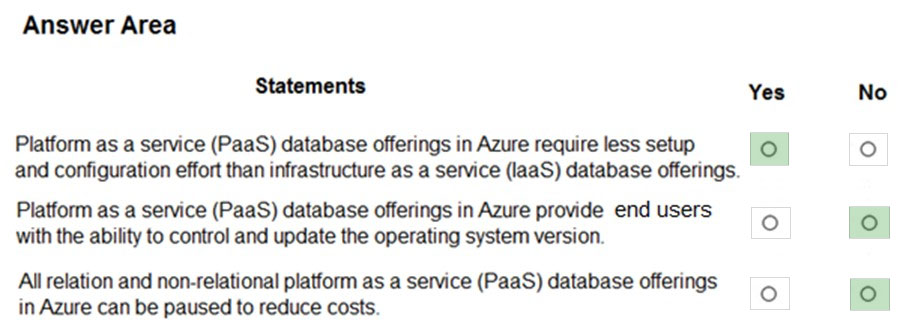
Box 1: Yes -
Like IaaS, PaaS includes infrastructure ג€" servers, storage, and networking ג€" but also middleware, development tools, business intelligence (BI) services, database management systems, and more. PaaS is designed to support the complete web application lifecycle: building, testing, deploying, managing, and updating.
PaaS allows you to avoid the expense and complexity of buying and managing software licenses, the underlying application infrastructure and middleware, container orchestrators such as Kubernetes, or the development tools and other resources
Box 2: No -
You manage the applications and services you develop, and the cloud service provider typically manages everything else.
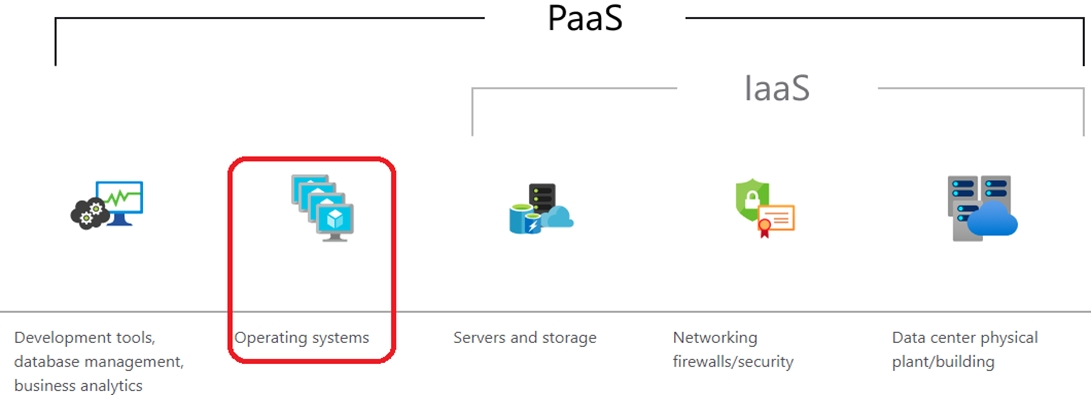
Box 3: No -
There really is no way to pause / stop billing for your Azure SQL Database.
Microsoft's official answer "Yes, you can export your database. Delete the Azure SQL database and that will pause billing. Then when you need it you can create a new database and import your previously exported DB."
Reference:
https://azure.microsoft.com/en-us/overview/what-is-paas

Box 1: Yes -
Like IaaS, PaaS includes infrastructure ג€" servers, storage, and networking ג€" but also middleware, development tools, business intelligence (BI) services, database management systems, and more. PaaS is designed to support the complete web application lifecycle: building, testing, deploying, managing, and updating.
PaaS allows you to avoid the expense and complexity of buying and managing software licenses, the underlying application infrastructure and middleware, container orchestrators such as Kubernetes, or the development tools and other resources
Box 2: No -
You manage the applications and services you develop, and the cloud service provider typically manages everything else.

Box 3: No -
There really is no way to pause / stop billing for your Azure SQL Database.
Microsoft's official answer "Yes, you can export your database. Delete the Azure SQL database and that will pause billing. Then when you need it you can create a new database and import your previously exported DB."
Reference:
https://azure.microsoft.com/en-us/overview/what-is-paas
send
light_mode
delete
Question #18
Which statement is an example of Data Manipulation Language (DML)?
- AREVOKE
- BDISABLE
- CINSERTMost Voted
- DGRANT
Correct Answer:
C
Data Manipulation Language (DML) affect the information stored in the database. Use these statements to insert, update, and change the rows in the database.
BULK INSERT -

✑ DELETE
✑ INSERT
✑ SELECT
✑ UPDATE
✑ MERGE
Reference:
https://docs.microsoft.com/en-us/sql/t-sql/statements/statements
C
Data Manipulation Language (DML) affect the information stored in the database. Use these statements to insert, update, and change the rows in the database.
BULK INSERT -

✑ DELETE
✑ INSERT
✑ SELECT
✑ UPDATE
✑ MERGE
Reference:
https://docs.microsoft.com/en-us/sql/t-sql/statements/statements
send
light_mode
delete
Question #19
You have a SQL query that combines customer data and order data. The query includes calculated columns.
You need to create a database object that would allow other users to rerun the same SQL query.
What should you create?
You need to create a database object that would allow other users to rerun the same SQL query.
What should you create?
- Aan index
- Ba viewMost Voted
- Ca scalar function
- Da table
Correct Answer:
B
A view is a virtual table whose contents are defined by a query. A view acts as a filter on the underlying tables referenced in the view. The query that defines the view can be from one or more tables or from other views in the current or other databases.
Reference:
https://docs.microsoft.com/en-us/sql/relational-databases/views/views
B
A view is a virtual table whose contents are defined by a query. A view acts as a filter on the underlying tables referenced in the view. The query that defines the view can be from one or more tables or from other views in the current or other databases.
Reference:
https://docs.microsoft.com/en-us/sql/relational-databases/views/views
send
light_mode
delete
Question #20
HOTSPOT -
To complete the sentence, select the appropriate option in the answer area.
Hot Area:

To complete the sentence, select the appropriate option in the answer area.
Hot Area:

Correct Answer:

Box 1: simple lookups -
A key/value store associates each data value with a unique key. Most key/value stores only support simple query, insert, and delete operations. To modify a value
(either partially or completely), an application must overwrite the existing data for the entire value. In most implementations, reading or writing a single value is an atomic operation.
An application can store arbitrary data as a set of values. Any schema information must be provided by the application. The key/value store simply retrieves or stores the value by key.
Reference:
https://docs.microsoft.com/en-us/azure/architecture/guide/technology-choices/data-store-overview

Box 1: simple lookups -
A key/value store associates each data value with a unique key. Most key/value stores only support simple query, insert, and delete operations. To modify a value
(either partially or completely), an application must overwrite the existing data for the entire value. In most implementations, reading or writing a single value is an atomic operation.
An application can store arbitrary data as a set of values. Any schema information must be provided by the application. The key/value store simply retrieves or stores the value by key.
Reference:
https://docs.microsoft.com/en-us/azure/architecture/guide/technology-choices/data-store-overview
send
light_mode
delete
All Pages
